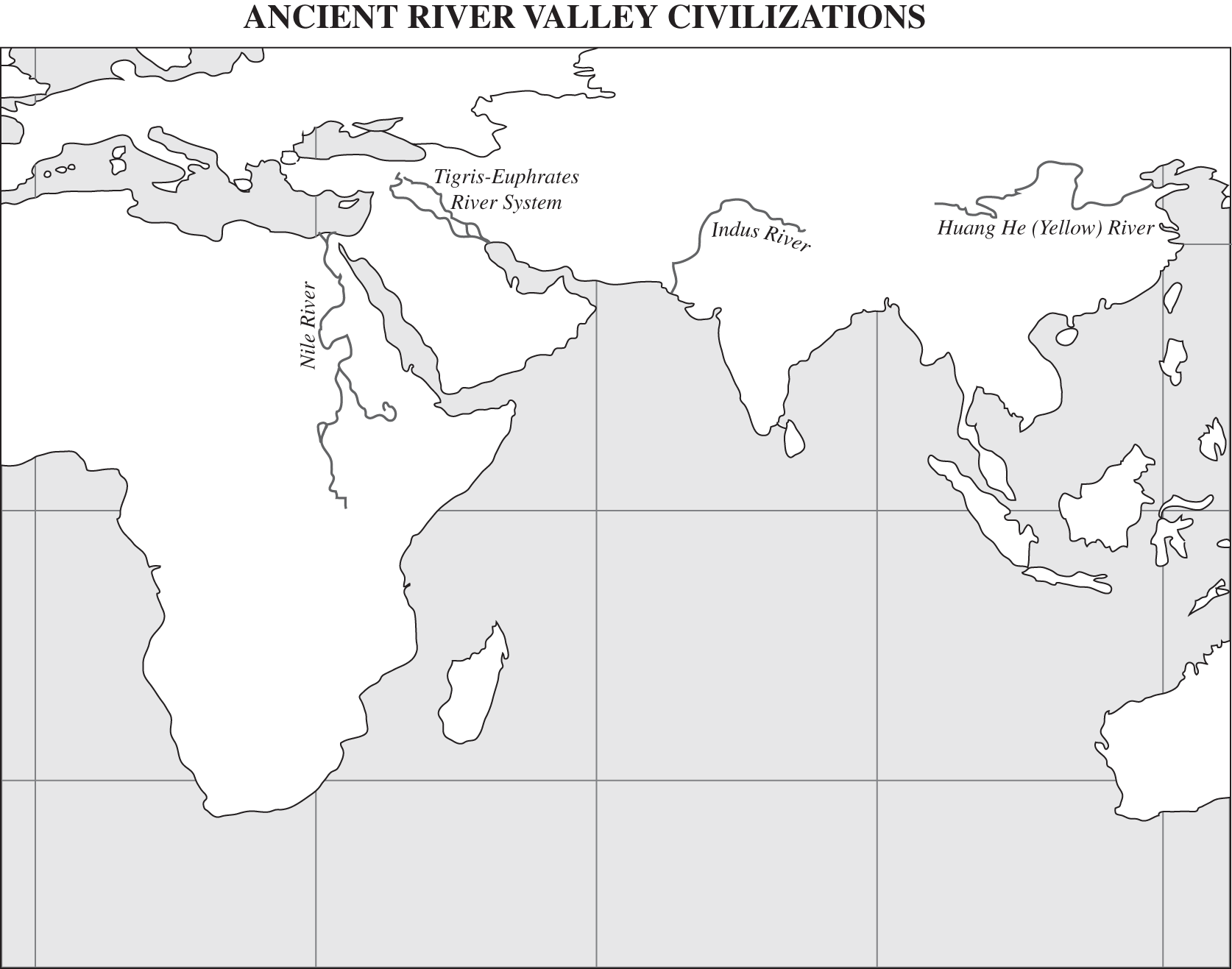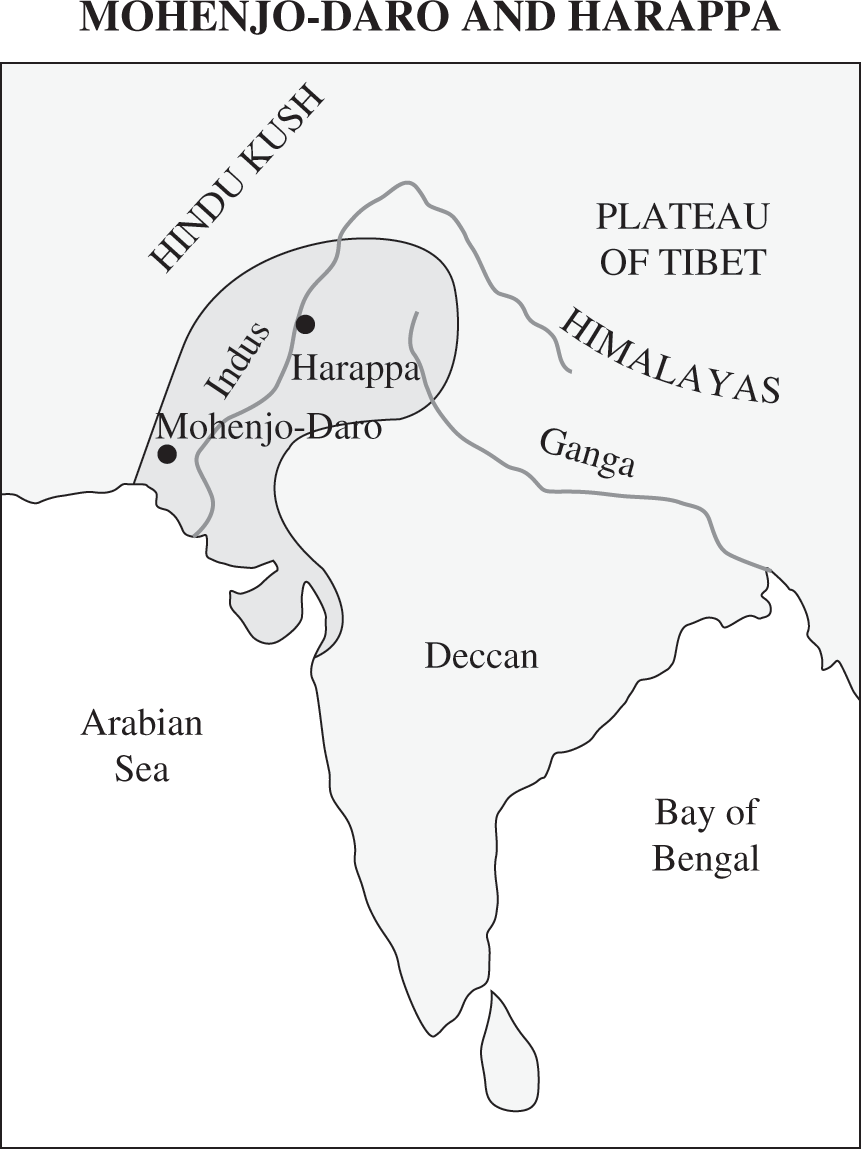Test What You Already Know
PART A: QUIZ
-
Questions 1–3 refer to the map below.
-

-
Which of the following correctly matches the river to the civilization that developed around it?
- Nile: Indian civilization
- Huang He (Yellow): Egyptian civilization
- Tigris and Euphrates: Mesopotamian civilization
- Indus: Chinese civilization
-
One society differs from the other three river valley civilizations pictured above in that it lacked
- polytheistic religion
- bronze tools and weapons
- pictographic writing
- social stratification
-
Which of the following statements correctly describes a consequence of establishing a society along a river?
- In China, the annual flooding cycles were quite predictable.
- In India, the Ganges River’s proximity allowed civilization to spread.
- In Mesopotamia, rivers confined trade to the Fertile Crescent.
- In Egypt, the river served as a natural barrier against invaders.
-
Questions 4–5 refer to the map below.
-

-
Mohenjo-Daro and Harappa were examples of
- oasis towns along the Silk Road
- dominant city-states in Ancient Greece
- port cities along the Mediterranean
- cities in the Indus River Valley
-
All of the following are featured at Mohenjo-Daro and Harappa except for
- repositories of deciphered texts
- streets and buildings laid out in grids
- large public baths and sewer systems
- expansive granaries for storing grain
-
-
Questions 6–8 refer to the passages below: Passage 1 is an excerpt from the Twelve Tables of Rome, circa 450 B.C.E., and Passage 2 is an excerpt from Hammurabi’s Code, circa 1750 B.C.E.
-
Passage 1
“Table III.
1. One who has confessed a debt, or against whom judgment has been pronounced, shall have thirty days to pay it in. After that forcible seizure of his person is allowed. . . .
Table V.
1. Females should remain in guardianship even when they have attained their majority. . . .
Table VIII.
2. If one has maimed a limb and does not compromise with the injured person, let there be retaliation. If one has broken a bone of a freeman with his hand or with a cudgel, let him pay a penalty of three hundred coins. If he has broken the bone of a slave, let him have one hundred and fifty coins. If one is guilty of insult, the penalty shall be twenty-five coins.
3. If one is slain while committing theft by night, he is rightly slain.”
Passage 2
“196. If a man put out the eye of another man, his eye shall be put out.
197. If he break another man's bone, his bone shall be broken.
198. If he put out the eye of a freed man, or break the bone of a freed man, he shall pay one gold mina.”
-
The ideas expressed in the passages above most strongly represent which of the following historical trends?
- The formal stratification of society
- The development of religious morality
- The idea that a republic’s leaders were not above the law
- An attempt to halt ongoing societal collapse
-
Which of the following did the Twelve Tables and Hammurabi’s Code have in common?
- Accusers could confront the accused in court.
- Punishments were written to fit the crime.
- Lower classes and higher classes were treated equally.
- Men and women were treated equally.
-
-
Both of these documents were intended to
- be flexible and change with the circumstances
- protect the lower classes from the abuse of upper classes
- provide democracy to their territories
- unify the diverse customs of diverse populations
-
Questions 9–10 refer to the following religious texts: Passage 1 is an excerpt from the New Testament’s Book of First Corinthians, Chapter 7; Passage 2 is a Buddhist poem translated by Thanissaro Bhikkhu, as written in the Therigatha.
-
Passage 1
“I would like you to be free from concern. An unmarried man is concerned about the Lord’s affairs—how he can please the Lord. But a married man is concerned about the affairs of this world—how he can please his wife—and his interests are divided. An unmarried woman or virgin is concerned about the Lord’s affairs: Her aim is to be devoted to the Lord in both body and spirit. But a married woman is concerned about the affairs of this world—how she can please her husband. I am saying this for your own good, not to restrict you, but that you may live in a right way in undivided devotion to the Lord.”
Passage 2
“Vimala: The Former Courtesan
Intoxicated with my complexion,
figure, beauty, & fame;
haughty with youth,
I despised other women.
Adorning this body
embellished to delude foolish men,
I stood at the door to the brothel:
a hunter with snare laid out.
I showed off my ornaments,
and revealed many a private part.
I worked my manifold magic,
laughing out loud at the crowd.
Today, wrapped in a double cloak,
my head shaven,
having wandered for alms,
I sit at the foot of a tree
and attain the state of no-thought.
All ties — human & divine — have been cut.
Having cast off all effluents,
cooled am I, unbound.” -
Which of the following statements most accurately compares the role of women in Christianity and Buddhism?
- In both religions, women could follow an alternative life in the monastery.
- In both religions, men were considered spiritually superior.
- Christianity attracted many female converts initially, while Buddhism attracted very few.
- Buddhist women could not read sacred texts, but Christian women could read the Bible.
-
Which of the following is a similarity between Buddhism and Christianity?
- Both religions have salvation as their ultimate goal.
- Both religions are monotheistic in nature.
- Both see their founders as fully human and fully divine.
- Both had several variations early in their history.
-
Part B: Key Topics
The following is a list of the major people, places, and events for Periods 1 and 2: up to 600 C.E. You will very likely see many of these on the AP World History exam.
For each key topic, ask yourself the following questions:
- Can I describe this key topic?
- Can I discuss this key topic in the context of other events?
- Could I correctly answer a multiple-choice question about this key topic?
- Could I correctly answer a free-response question about this key topic?
Check off the key topics if you can answer “yes” to at least three of these questions.
Early Humans
- Paleolithic
- Animism
Development of Agriculture
- Neolithic Revolution
- Pastoralism
- Job specialization
- Patriarchy
- Metallurgy
- Mesopotamia
The First Civilizations
- Assyria
- Shang
- Cuneiform
- Ziggurats
- Hammurabi’s Code
- Phoenicians
- Egypt
- Pictographs
- Roman empire
- Hebrews
- Harappa and Mohenjo-daro
- Vedas
- Hinduism
- Caste system
- Mandate of Heaven
- Qin dynasty
- Olmecs
- Chavin
- Maya empire
Classical Societies
- Persia
- Alexander the Great
- Hellenistic
- Mauryan empire
- Ashoka
- Gupta empire
- Daoism
- Han dynasty
- Silk Road
- Filial piety
- Republic
- Diaspora
- Christianity
- Monsoon winds
- Indian Ocean trade
Development and Spread of Religion
- Shamanism
- Ancestor veneration
- Brahma
- Buddha
- Confucius
- Islam
- Zoroastrianism
Part B: Count the number of key topics you checked off.
out of 50 key topics
Your Results
Next StepsQuiz Key Topics You answered 8+ questions correctly AND You checked off 40+ (80%+) key topics - Review the quiz explanations at the back of the book.
- Read the Rapid Review in this chapter.
- Complete the Test What You Learned section in this chapter and review the quiz explanations.
You answered 5–7 questions correctly OR You checked off 25–39 (50–79%) key topics - Review the quiz explanations at the back of the book.
- Read the Rapid Review in this chapter.
- Go to the Complete Time Period Review for this period in Part 3. Read each High-Yield section about the key topics you did not check off. If you are short on time, read as many of these High-Yield sections as you are able.
- Complete the Test What You Learned section in this chapter and review the quiz explanations.
You answered <5 questions correctly AND You checked off <25 (<50%) key topics - Review the quiz explanations at the back of the book.
- Read the Rapid Review in this chapter.
- Go to the
Complete Time Period Review for this period in Part 3 and:
- If you have time in your study schedule, study the full chapter.
- If you are short on time, focus on High-Yield sections and the key topics with which you are least familiar.
- Complete the Test What You Learned section in this chapter and review the quiz explanations.
-
-